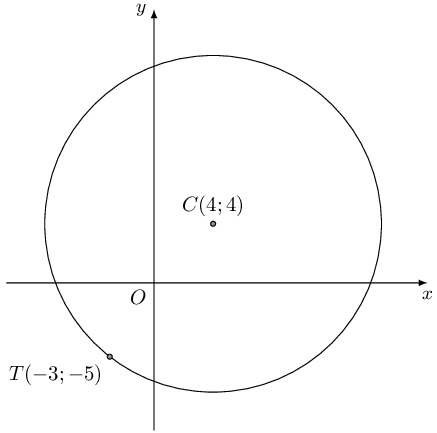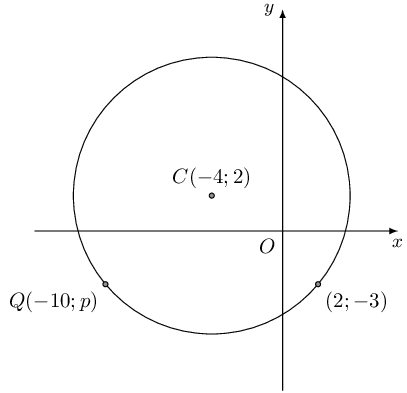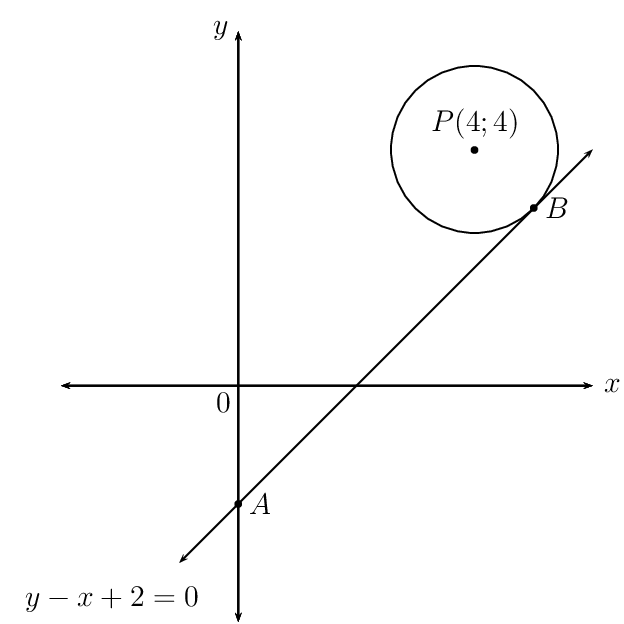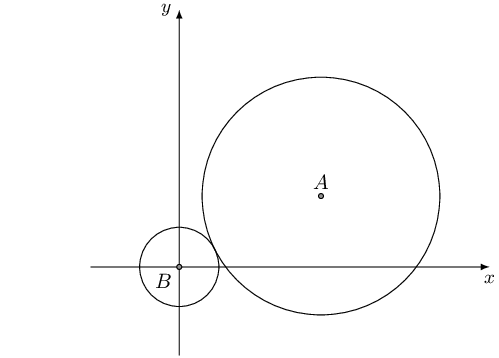with centre \(\left(0;5\right)\) and radius \(\text{5}\)
End of chapter exercises
|
Previous
7.4 Summary
|
Next
8.1 Revision
|
End of chapter exercises
Find the equation of the circle:
with centre \(\left(2;0\right)\) and radius \(\text{4}\)
with centre \(\left(-5;7\right)\) and radius \(\text{18}\)
with centre \(\left(-2;0\right)\) and diameter \(\text{6}\)
with centre \(\left(-5;-3\right)\) and radius \(\sqrt{3}\)
Find the equation of the circle with centre \(\left(2;1\right)\) which passes through \(\left(4;1\right)\).
Where does it cut the line \(y=x+1\)?
Find the equation of the circle with centre \(\left(-3;-2\right)\) which passes through \(\left(1;-4\right)\).
Find the equation of the circle with centre \(\left(3;1\right)\) which passes through \(\left(2;5\right)\).
Find the centre and radius of the following circles:
\({\left(x+9\right)}^{2}+{\left(y-6\right)}^{2}=36\)
\(\frac{1}{2}{\left(x-2\right)}^{2}+\frac{1}{2}{\left(y-9\right)}^{2}=1\)
\({\left(x+5\right)}^{2}+{\left(y+7\right)}^{2}=12\)
\(x^{2}+{\left(y+4\right)}^{2}=23\)
\(3{\left(x-2\right)}^{2}+3{\left(y+3\right)}^{2}=12\)
Find the \(x\) and \(y\) intercepts of the following graphs:
\({x}^{2}+{\left(y-6\right)}^{2}=100\)
\({\left(x+4\right)}^{2}+{y}^{2}=16\)
Find the centre and radius of the following circles:
\({x}^{2}+6x+{y}^{2}-12y=-20\)
The centre of the circle is \((-3;6)\) and \(r = 5\) units.
\({x}^{2}+4x+{y}^{2}-8y=0\)
The centre of the circle is \((-2;4)\) and \(r = \sqrt{20}\) units.
\({x}^{2}+{y}^{2}+8y=7\)
The centre of the circle is \((0;-4)\) and \(r = \sqrt{23}\) units.
\({x}^{2}-6x+{y}^{2}=16\)
The centre of the circle is \((3;0)\) and \(r = 5\) units.
\({x}^{2}-5x+{y}^{2}+3y=-\frac{3}{4}\)
The centre of the circle is \((\frac{5}{2};-\frac{3}{2})\) and \(r = \frac{\sqrt{31}}{2}\) units.
\({x}^{2}-6nx+{y}^{2}+10ny=9{n}^{2}\)
The centre of the circle is \((3n;-5n)\) and \(r = \sqrt{43}n\) units.
Find the gradient of the radius between the point \((4;5)\) on the circle and its centre \((-8;4)\).
Given:
- the centre of the circle \((a;b) = (-8;4)\)
- a point on the circumference of the circle \((4;5)\)
Required:
- the gradient \(m\) of the radius
The gradient for this radius is \(m = \frac{1}{12}\).
Find the gradient line tangent to the circle at the point \((4;5)\).
The tangent to the circle at the point \((4;5)\) is perpendicular to the radius of the circle to that same point:
\begin{align*} m_{\bot} & = - \frac{1}{m}\\ & = \frac{-1}{\frac{1}{12} }\\ & = -12 \end{align*}The gradient for the tangent is \(m_{\bot} = -12\).
Given \(\left(x - 1\right)^{2} + \left(y - 7\right)^{2} = 10\), determine the value(s) of \(x\) if \((x;4)\) lies on the circle.
The points \((0;4)\) and \((2;4)\) lie on the circle.
\((0;4),(2;4)\)Find the gradient of the tangent to the circle at the point \((2;4)\).
The gradient of the tangent is \(m_{\text{tangent}} = \frac{1}{3}\).
\(m = \frac{1}{3}\)Given a circle with the central coordinates \((a;b) = (-2;-2)\). Determine the equation of the tangent line of the circle at the point \((-1;3)\).
The radius is perpendicular to the tangent, therefore \(m_{r} \times m_{\bot} = -1\):
\[m_{\bot} = - \frac{1}{5}\]Substitute \(m = - \frac{1}{5}\) and \((-1;3)\) to determine \(c\):
\begin{align*} y & =m_{\bot} x + c\\ 3 & = - \frac{1}{5} (-1) + c \\ c & = \frac{14}{5} \end{align*}The equation of the tangent to the circle at the point \((-1;3)\) is \(y = - \frac{1}{5} x + \frac{14}{5}\).
\(y = - \frac{1}{5} x + \frac{14}{5}\)Consider the diagram below:

Find the equation of the tangent to the circle at point \(T\).
Determine the \(y\)-intercept (\(c\)) of the line by substituting the point \(T(-3;-5)\).
\begin{align*} y & = m x + c\\ -5 & = - \frac{7}{9} (-3) + c \\ c & = - \frac{22}{3} \end{align*}The equation of the tangent to the circle at \(T\) is
\begin{align*} y & = - \frac{7}{9} x - \frac{22}{3} \end{align*} \(y = - \frac{7}{9} x - \frac{22}{3}\)\(M(-2;-5)\) is a point on the circle \(x^{2} + y^{2} + 18y + 61 = 0\). Determine the equation of the tangent at \(M\).
Complete the square:
\begin{align*} x^{2} + y^{2} + 18y + 61 &= 0 \\ x^{2} + (y^{2} + 18y) &= -61 \\ x^{2} + (y + 9)^{2} - 81 &= -61 \\ x^{2} + (y + 9)^{2} &= 20 \end{align*}Therefore the centre of the circle is \((0;-9)\) and \(r = \sqrt{20}\) units.
Calculate the gradient of the radius:
\begin{align*} m_r & = \frac{y_1 - y_0}{x_1 - x_0} \\ & = \frac{-5 - (-9)}{-2 - 0} \\ & = \frac{4}{-2} \\ & = -2 \end{align*} \begin{align*} m_{\bot} & = - \frac{1}{m_r} \\ & = - \frac{1}{-2} \\ & = \frac{1}{2} \end{align*}Determine the \(y\)-intercept \(c\) of the line by substituting the point \(M(-2;-5)\).
\begin{align*} y & = m_{\bot} x + c\\ -5 & = \frac{1}{2} (-2) + c \\ c & = -4 \end{align*}The equation for the tangent to the circle at the point \(M(-2;-5)\) is
\begin{align*} y & = \frac{1}{2} x - 4 \end{align*} \(y = \frac{1}{2} x - 4\)\(C(-4;2)\) is the centre of the circle passing through \((2;-3)\) and \(Q(-10;p)\).

Find the equation of the circle given.
The equation of the circle is \(\left(x + 4\right)^{2} + \left(y - 2\right)^{2} = 61\).
\(\left(x + 4\right)^{2} + \left(y - 2\right)^{2} = 61\)Determine the value of \(p\).
From the graph we see that the correct \(y\)-value is \(-\text{3}\).
The coordinates for point \(Q\) is \(Q(-10;-3)\)
\(p = -3\)Determine the equation of the tangent to the circle at point \(Q\).
\(m_{r} \times m_{\bot} = -1\).
\begin{align*} m_{\bot} & = - \frac{1}{m_r} \\ & = - \dfrac{1}{\frac{5}{6}} \\ & = - \frac{6}{5} \end{align*}Determine the \(y\)-intercept \(c\) of the line by substituting the point \(Q(x_2;y_2) = (-10;-3)\).
\begin{align*} y_2 & = m_{\bot} x_2 + c\\ -3 & = - \frac{6}{5} (-10) + c \\ c & = -15 \end{align*}The equation of the tangent to the circle at \(Q\) is \(y = - \frac{6}{5} x - 15\).
Find the equation of the tangent to each circle:
\({x}^{2}+{y}^{2}=17\) at the point \(\left(1;4\right)\)
The centre of the circle is \((0;0)\) and \(r = \sqrt{17}\) units.
\begin{align*} m_{r} & = \frac{y_2 - y_1}{x_2 - x_1} \\ & = \frac{4 - 0}{1 - 0} \\ & = 4 \end{align*} \begin{align*} m_{r} & \times m_{\bot} = -1 \\ m_{\bot} & = - \frac{1}{m_{r}} \\ & = - \dfrac{1}{4} \\ & = - \frac{1}{4} \end{align*} \begin{align*} y_2 & = m_{\bot} x_2 + c\\ 4 & = - \frac{1}{4}(1) + c \\ c & = \frac{17}{4} \end{align*}The equation of the tangent to the circle is \(y = - \frac{1}{4} x + \frac{17}{4}\).
\({x}^{2}+{y}^{2}=25\) at the point \(\left(3;4\right)\)
The centre of the circle is \((0;0)\) and \(r = 5\) units.
\begin{align*} m_{r} & = \frac{y_2 - y_1}{x_2 - x_1} \\ & = \frac{4 - 0}{3 - 0} \\ & = \frac{4}{3} \end{align*} \begin{align*} m_{r} & \times m_{\bot} = -1 \\ m_{\bot} & = - \frac{1}{m_{r}} \\ & = - \dfrac{1}{\frac{4}{3} } \\ & = - \frac{3}{4} \end{align*} \begin{align*} y_2 & = m_{\bot} x_2 + c\\ 4 & = - \frac{3}{4}(3) + c \\ c & = \frac{25}{4} \end{align*}The equation of the tangent to the circle is \(y = - \frac{3}{4} x + \frac{25}{4}\).
\({\left(x+1\right)}^{2}+{\left(y-2\right)}^{2}=25\) at the point \(\left(3;5\right)\)
The centre of the circle is \((-1;2)\) and \(r = 5\) units.
\begin{align*} m_{r} & = \frac{y_2 - y_1}{x_2 - x_1} \\ & = \frac{5-2}{3 - (-1)} \\ & = \frac{3}{4} \end{align*} \begin{align*} m_{r} & \times m_{\bot} = -1 \\ m_{\bot} & = - \frac{1}{m_{r}} \\ & = - \dfrac{1}{\frac{3}{4} } \\ & = - \frac{4}{3} \end{align*} \begin{align*} y_2 & = m_{\bot} x_2 + c\\ 5 & = - \frac{4}{3}(3) + c \\ c & = 9 \end{align*}The equation of the tangent to the circle is \(y = - \frac{4}{3} x + 9\).
\({\left(x-2\right)}^{2}+{\left(y-1\right)}^{2}=13\) at the point \(\left(5;3\right)\)
The centre of the circle is \((2;1)\) and \(r = \sqrt{13}\) units.
\begin{align*} m_{r} & = \frac{y_2 - y_1}{x_2 - x_1} \\ & = \frac{3-1}{5-2} \\ & = \frac{2}{3} \end{align*} \begin{align*} m_{r} & \times m_{\bot} = -1 \\ m_{\bot} & = - \frac{1}{m_{r}} \\ & = - \dfrac{1}{\frac{2}{3} } \\ & = - \frac{3}{2} \end{align*} \begin{align*} y_2 & = m_{\bot} x_2 + c\\ 3 & = - \frac{3}{2}(5) + c \\ c & = \frac{21}{2} \end{align*}The equation of the tangent to the circle is \(y = - \frac{3}{2} x + \frac{21}{2}\).
Determine the equations of the tangents to the circle \(x^{2} + y^{2} = 50\), given that both lines have an angle of inclination of \(\text{45} °\).
The centre of the circle is \((0;0)\) and \(r = \sqrt{50}\) units.
Gradient of the tangents:
\begin{align*} m & = \tan \theta \\ & = \tan{ \text{45} °} \\ & = 1 \end{align*} \begin{align*} m & \times m_{\bot} = -1 \\ m & = - 1 \end{align*}The line perpendicular to the tangents and passing through the centre of the circle is \(y = -x\). Substitute \(y = -x\) into the equation of the circle and solve for \(x\):
\begin{align*} x^{2} + (-x)^{2} &= 50 \\ 2x^{2} &= 50 \\ x^{2} &= 25 \\ x &= \pm 5 \end{align*}This gives the points \(P(-5;5)\) and \(Q(5;-5)\).
Tangent at \(P(-5;5)\):
\begin{align*} y - 5 & = (1)(x - (-5)) \\ y & = x + 10 \end{align*}Tangent at \(Q(5;-5)\):
\begin{align*} y - (-5) & = (1)(x - 5) \\ y & = x - 10 \end{align*}The equations of the tangents to the circle are \(y = x - 10\) and \(y = x + 10\).
The circle with centre \(P(4; 4)\) has a tangent \(AB\) at point \(B\). The equation of \(AB\) is \(y - x + 2 = 0\) and \(A\) lies on the \(y\)-axis.

Determine the equation of \(PB\).
Determine the coordinates of \(B\).
Equate the two equations and solve for \(x\):
\begin{align*} x -2 & = -x + 8 \\ 2x & = 10 \\ x & = 5 \\ y &= -5 + 8 \\ \therefore y &= 3 \end{align*}\(B(5;3)\)
Determine the equation of the circle.
Describe in words how the circle must be shifted so that \(P\) is at the origin.
If the length of \(PB\) is tripled and the circle is shifted \(\text{2}\) units to the right and \(\text{1}\) unit up, determine the equation of the new circle.
The equation of a circle with centre \(A\) is \(x^{2} + y^{2} + 5 = 16x + 8y - 30\) and the equation of a circle with centre \(B\) is \(5x^{2} + 5y^{2} = 25\). Prove that the two circles touch each other.
Therefore the two circles touch each other.

|
Previous
7.4 Summary
|
Table of Contents |
Next
8.1 Revision
|
